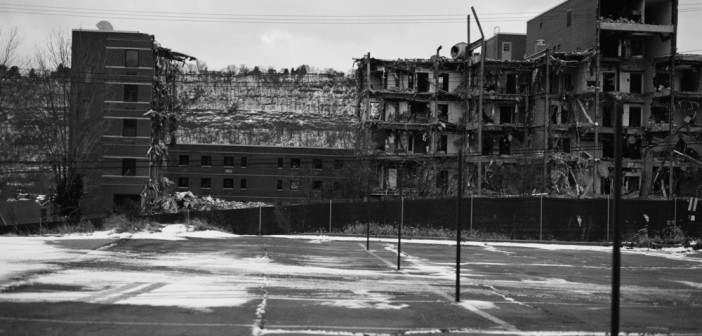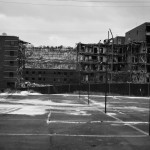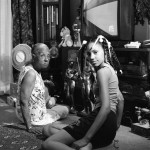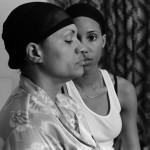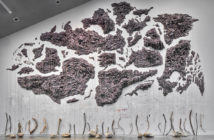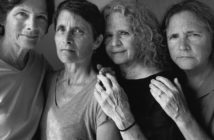Forget objectivity; LaToya Ruby Frazier is an activist at heart. Frazier operates on the inside, and her photography cannot be adequately judged within the category of journalism. Although her photographs invite comparison to the iconic WPA photographs of Dorothea Lange that influenced her as a young artist, Frazier is not interested in documenting events as they happened. Instead, her work manipulates the visual legacy of social documentary as her work begs us to accept her personal narrative as a paradigm for the culture of the Rust Belt. In WITNESS, (on view at the Institute of Contemporary Art, Boston through March 2) Frazier’s photographs of her hometown of Braddock, Pennsylvania offer a diaristic counterpoint to the mainstream portrayal of the post-industrial city. The show begins with scenes of home but it moves toward a broader narrative of disenfranchisement.
Many photographers have made work about the devastation of American cities following natural or economic disasters. Flocking to document affected areas in aftermath of Hurricane Katrina or the deindustrialization of Detroit, these photographs show us the troubles of our neighbors living on the edge of calamity. Although these crises are printed and packaged to present information accurately and fairly, there will be winners and losers in the newsroom.
People rarely examine the societal norms that give objectivity its veneer of legitimacy. What we consider to be "fair" is a judgment made by our culture, and as our values change so does our idea of the truth. We, as a culture, tend to focus on those with an obvious axe to grind when we seek out bias, but inaction can take the form of activism when its object is to maintain the status quo. Power is often content to don the appearance of impartiality by merely acknowledging the plight of the powerless, without actually acting to reverse injustices. It’s the power to not act that can lead to the precarious state of disrepair in towns like Braddock.
 LaToya Ruby Frazier , Grandma Ruby and Me, 2005
LaToya Ruby Frazier , Grandma Ruby and Me, 2005Silver gelatin print
20 x 24 inches
Courtesy of the artist and Galerie Michel Rein, Paris
Braddock has made it into the news recently. The city’s mayor, John Fetterman, has generated interest in the national media with his attempts to repopulate the town by pitching it as a place affordable to artists and young creative types. Since its heyday in the 60s, the town has lost 90% of its residents, and currently struggles to maintain adequate services for those that remain.
With a tax base as small as Braddock’s, Fetterman’s power hinges primarily on can-do optimism and a willingness to try, characteristics that lend him all the components of an underdog rags-to-riches story, except the riches. However, for those very reasons, Hollywood and corporate America have been showing signs of interest. Scott Cooper’s Out of the Furnace features characters living in Braddock, and perhaps less flatteringly, the town also was used as one of the locations for the post-apocalyptic adaptation of Cormac McCarthy’s The Road.
While many praise Fetterman’s tenacity, Frazier does not see this brand of gentrification as benign. In the series Campaign for Braddock Hospital (Save Our Community Hospital) (2011), she marks up images pulled from ads championing Braddock’s "pioneer" spirit made by Weiden + Kennedy for Levi’s, writing comments and revisions in by hand. The relationship between the closing of UPMC Braddock and Levi’s is an emotional one; both are companies that ostensibly attempted to help the community, but ones that Frazier feels don’t have a real interest in the people of Braddock or a respect for their history.
 LaToya Ruby Frazier , U.P.M.C. Braddock Hospital and Holland Avenue Parking Lot, 2011. Silver gelatin print
LaToya Ruby Frazier , U.P.M.C. Braddock Hospital and Holland Avenue Parking Lot, 2011. Silver gelatin print48 x 60 inches
Courtesy of the artist and Galerie Michel Rein, Paris
The artist examines the issue of environmental toxins as a legacy of industrial negligence, and very viscerally we are introduced to the foundations of her concern. In Landscape of the Body (Epilepsy Test) (2011), we see the tension between the precarious decay of buildings crumbling—exteriors falling inward in a crumpled heap of spent material— echoed in the diagonals of her mother’s back and thick tangles of diagnostic wires in the hospital. This work is a reminder that our homes and our health are self-delusions we cultivate in order to feel safe, and we are barely holding on.
Frazier’s home life was dominated by the feminine presence of her mother and grandmother. Each of these women experienced a different reality: Grandma Ruby saw the rise of an industrial city, LaToya’s mother grew up during its heyday, and LaToya was shaped by the disappointment of its collapse and the rapid decline in the town’s remaining population. The interiors look familiar, filled to overflowing with belongings and personal idiosyncrasies. The sadness of loss is palpable as they slide toward emptiness.
Exposed to environmental and emotional toxicity, we observe Frazier’s family and community slowly succumb to a lack of care as their local medical facilities shut down, leaving the elderly and infirm without access to quality treatment. In the video DETOX (Braddock U.P.M.C.) (2011), scenes of an intimate conversation between mother and daughter/camera at home are interspersed with footage of Frazier and her mother undergoing ionic cleanse foot baths at UPMC before the facility’s closure. Frazier’s mother exemplifies this conceptual collision at one point, as she refrains for the camera, "What do I care, if they don’t care."
This intimacy is a powerful tool, mimicking the methods by which we acquire tacit knowledge by conveying the experience of being there. Unlike learned knowledge, tacit knowledge favors observation and experience over a direct articulation of facts, and thus the power to gain our trust is proportionate to the level of vulnerability we see.
For the Momme (2010) series of co-portraits mother and daughter are unvarnished and subtle. These raw domestic interactions are visually unbroken by much more than a simple sheet serving as a backdrop, defining a private space even more interior than the four walls of a home. They appear so natural that it is easy to forget that they are completely staged, an ongoing collaboration between the two women. The tension in the images speaks toward the balance of wills in Frazier’s complicated relationship with her mother, and in their demeanor we recognize the archetypal mother/daughter dynamic.
 LaToya Ruby Frazier, Momme, 2008. Silver gelatin print
LaToya Ruby Frazier, Momme, 2008. Silver gelatin print30 x 40 inches
Courtesy of the artist and Galerie Michel Rein, Paris
Though the ambiguity of the work with her family is part of what makes it so powerful, the genius of Frazier’s approach is also her blind spot. By involving her loved ones in her process, Frazier constrains herself to narratives that leave those relationships intact. Frazier focuses blame on outsiders for the state of things in Braddock, but she walks much more softly in accounting for the role of individual choice —of Grandma Ruby’s smoking her Pall Malls in her cancer or her mother’s struggles with addiction as a factor in her mental illness. Judgments are slippery things, drawing conclusions about the past by the state of the present. While environmental or industrial pollution could absolutely be a factor in chronic illness, so could genetics, lifestyle, and access to care. For the poor, this is often a hydra’s head of factors that makes absolute judgments impossible, and accountability harder to bring to bear where it may be warranted.
In this edit of a decade of work, Frazier’s disillusion with authority as the custodian of the people and as an agent of change for the better is clear. She places empathy for human frailty and a desire to see the marginalized empowered to represent themselves through their stories at the heart of WITNESS.
While Frazier’s experience is of Braddock, it is not the Braddock experience. Her narrative of the city coexists with those of Levi’s, Fetterman and other Braddock residents. If America is a quilt of mini-nations fighting for survival within our borders, then the nature of that power struggle is to project the vision and the bias of the empowered into the annals our history.
LaToya Ruby Frazier has borne witness, but now that her testimony is recorded, are we closer to the truth? For Braddock, the truth might belong to the last inhabitant standing.
- LaToya Ruby Frazier , U.P.M.C. Braddock Hospital and Holland Avenue Parking Lot, 2011. Silver gelatin print 48 x 60 inches Courtesy of the artist and Galerie Michel Rein, Paris
- LaToya Ruby Frazier , Grandma Ruby and Me, 2005 Silver gelatin print 20 x 24 inches Courtesy of the artist and Galerie Michel Rein, Paris
- LaToya Ruby Frazier, Momme, 2008. Silver gelatin print 30 x 40 inches Courtesy of the artist and Galerie Michel Rein, Paris
LaToya Ruby Frazier, WITNESS, is on view at ICA Boston until March 2, 2014
For more information, visit their website.

